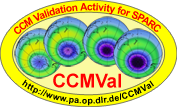 |
CCM Validation Activity for SPARC (CCMVal) |
 |
CCM Validation Activity for SPARC (CCMVal) |
|
|
| TYPE
OF NOTE |
MODEL |
NOTES,
ERRATA, and UPDATES |
DATE |
CONTACT
FOR QUESTIONS |
| Updated
CCMVal-1 Run |
MRI |
/project_spaces/ccmval/DYNAMICS/MRI/REF1/README_MRI_ref1.1_PRM5_v2_DYN.txt Kiyotaka Shibata and Makoto Deushi (Meteorological Research Institute) Updated: 31 January, 2007 Result of ref1.1_PRM5_v2 run ------------------------------------------------------------------------- Result for DYNAMICS data request of ref1.1_PRM5_v2 run is uploaded in ../ccmval/DYNAMICS/MRI/REF1/MRI_ref1.1_PRM5_v2 directory, whereas that for WMO2006 data request is in ../ccmval/NEW_RUNS/REF1/MRI/MRI_ref1.1_PRM5_v2 directory. Versions of MRI-CCM simulations ----------------------------------------------------------------------------------- ref1.1 : Qubic3 HZDF_150_hrs Sol_11_yr_rad error Sol_11_yr_photo error ref1.1_PRM5 : PRM5 HZDF_150_hrs No_error Sol_11_yr_photo error ref1.1_PRM5_v2 : PRM5 HZDF_100_hrs No_error No_error ref2.1 : Qubic3 HZDF_150_hrs ref2.1_PRM5 : PRM5 HZDF_150_hrs >> About Qubic3 and PRM5 << MRI-CCM adopts a hybrid semi-Lagrangian transport scheme, which is compatibly solved with the continuity equation and has different forms for horizontal and vertical directions [Shibata et al., 2005]. The horizontal form is an ordinary semi-Lagrangian scheme, while the vertical form is equivalent to a mass-conserving flux-form in transformed pressure coordinate specified by vertical velocity. However, the hybrid semi-Lagrangian transport scheme describes only general formulation without specifying the way calculating abundances at horizontal departure point in the transformed vertical coordinate. Cubic3 uses a cubic interpolation of neighboring abundances in the horizontal and also uses it for overhead column abundances in the vertical [Shibata et al., 2005]. To the Cubic3 scheme, a new PRM5 scheme is developed by improving both vertical and horizontal procedures to simulate better distributions of chemical constituents; the vertical procedure employs the piecewise rational method (PRM) [Xiao and Peng, 2004] and the horizontal procedure uses a quintic interpolation. PRM, which uses an analytically integrable rational function in reconstructing in-cell profiles from cell-averaged values, exhibits better performance for sharp gradient profiles than the piecewise parabolic method (PPM) [Colella and Woodward, 1984] using a parabolic function. This improvement of the transport scheme led to, for example, a substantial improvement decreasing ozone positive biases, particularly in the tropical upper troposphere and lower stratosphere. >> About HZDF_150_hrs and HZDF_100_hrs << The e-folding time at the maximum wavenumver 42 for the biharmonic horizontal diffusion in the middle atmosphere above 100 hPa: HZDF_150_hrs represents 150 hours and HZDF_100_hrs represents 100 hours. >> About Sol_11_yr_rad error << A bug for UV variations associated with the solar 11-year cycle. Along with total solar irradiance (TSI) variations, not only UV+VIS irradiance but also NIR irradiance was changed in the run. Since the sums of irradiances in the two spectral regions are almost similar magnitudes, the amplitude of UV+VIS irradiance was underestimated to be about a half of the correct one, together with an overestimation of the NIR amplitude. After being corrected, the variations in TSI were converted solely to those in UV+VIS irradiance with NIR irradiance being fixed. >> Sol_11_yr_photo error << A bug for photolysis variations associated with the solar 11-year cycle. Photodissociation look-up tables for all the months were found to be the same contents. After being corrected, photodissociation coefficients are confirmed to vary with the solar 11-year cycle. STATUS: ---------------------------------------------- We have completed the ref1.1_PRM5_v2 run. |
31/01/07 |
K. Shibata M. Deushi |
| Updated CCMVal-1 Run | ULAQ |
/project_spaces/ccmval/NEW_RUNS/REF2/ULAQ/readme.txt
Eva Mancini and Gianni Pitari (ULAQ group) The ULAQ group has submitted a new REF2 simulation (1960-2050) carried out with an updated model version. These data are istored in the directory
/project_spaces/ccmval/NEW_RUNS/REF2/ULAQ.
Each file, in ICD format, contain the data from 1960 to 2050,
except the files containing the 3-D fields which are for period
1980-2000. All files are named appending "_1" to names proposed in ICD
to distinguish them from those products with the previous version of
the model evaluated in Eyring et al 2006, 2007. The new results are
obtained with an updated version of the ULAQ-CCM. The major differences
with respect to the previous model version are:
a)
Assimilated observed tropical winds are included in GCM to simulate the
QBO effects in the model. The assimilation procedure is based on
Giorgetta and Bengtsson (J. Geophys. Res., 104,6003-6019, 1999). b) Refinement
and update of the parameterization of cirrus cloud particles in the
UTLS.
It would be nice if in future
you will use these new data instead of the previous ones.
|
19/02/07 |
E.
Mancini G. Pitari |
| New
CCM participating in CCMVal-1 |
LMDz INCA |
Data stored in the directory /project_spaces/ccmval/DYNAMICS/LMDzINCA | 23/02/07 |
F. Jégou D. Hauglustaine |
| Last modified: 17 September 2008 | |
| by Veronika
Eyring |